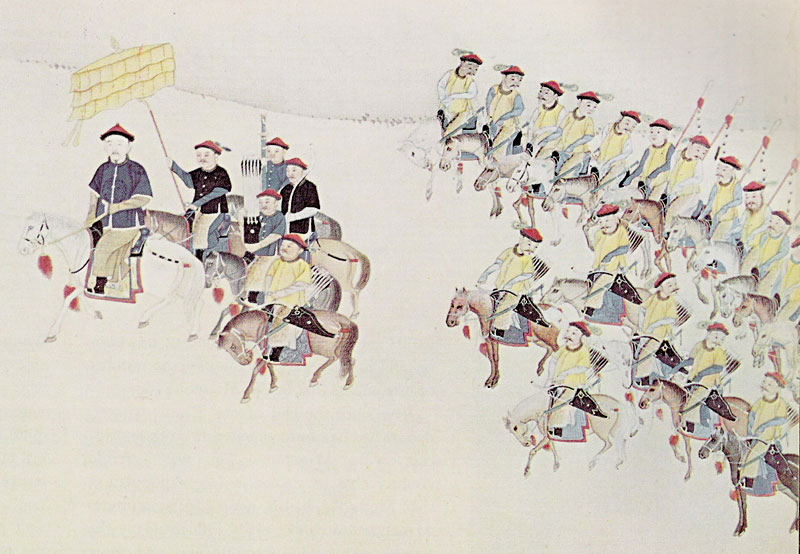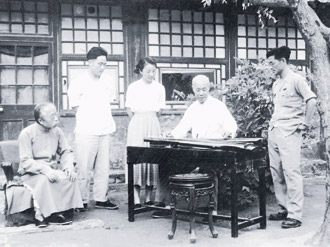|
Prince Yu (愉)
Prince Yu of the Second Rank, or simply Prince Yu, was the title of a princely peerage used in China during the Manchu-led Qing dynasty (1644–1912). As the Prince Yu peerage was not awarded "iron-cap" status, this meant that each successive bearer of the title would normally start off with a title downgraded by one rank ''vis-à-vis'' that held by his predecessor. However, the title would generally not be downgraded to any lower than a ''feng'en fuguo gong'' except under special circumstances. The first bearer of the title was Yunxu (允禑; 1693–1731), the 15th son of the Kangxi Emperor. In 1730, Yunxu was granted the title "Prince Yu of the Second Rank" by the Qianlong Emperor. The title was passed down over seven generations and held by seven persons. Members of the Prince Yu peerage * Yunxu (允禑; 1693 – 1731; 1st), the Kangxi Emperor's 15th son, initially a ''beile'', promoted to second-rank prince under the title "Prince Yu of the Second Rank" in 1730, posthum ... [...More Info...] [...Related Items...] OR: [Wikipedia] [Google] [Baidu] |
Royal And Noble Ranks Of The Qing Dynasty
The Qing dynasty (1644–1912) of China developed a complicated peerage system for royal and noble ranks. Rule of inheritance In principle, titles were downgraded one grade for each generation of inheritance. * Direct imperial princes with the ''Eight Privileges'' were downgraded for four generations, after which the title can be inherited without further downgrades. * Direct imperial princes without the ''Eight Privileges'' were downgraded until the rank of ''feng'en jiangjun'', which then became perpetual. * Cadet line imperial princes and lords were downgraded until they reached ''feng'en jiangjun'', which could be further inherited three times before the title expired completely. * For non-imperial peers, the title could be downgraded to ''en jiwei'' before becoming perpetually heritable. Occasionally, a peer could be granted the privilege of ''shixi wangti'' ( zh, t=世襲罔替, p=shìxí wǎngtì, labels=no; "perpetual heritability"), which allowed the title to be p ... [...More Info...] [...Related Items...] OR: [Wikipedia] [Google] [Baidu] |
Manchu People
The Manchus (; ) are a Tungusic peoples, Tungusic East Asian people, East Asian ethnic group native to Manchuria in Northeast Asia. They are an officially recognized Ethnic minorities in China, ethnic minority in China and the people from whom Manchuria derives its name. The Later Jin (1616–1636), Later Jin (1616–1636) and Qing dynasty, Qing (1636–1912) dynasties of China were established and ruled by the Manchus, who are descended from the Jurchen people who earlier established the Jin dynasty (1115–1234), Jin dynasty (1115–1234) in northern China. Manchus form the largest branch of the Tungusic peoples and are distributed throughout China, forming the fourth largest ethnic group in the country. They are found in 31 Chinese provincial regions. Among them, Liaoning has the largest population and Hebei, Heilongjiang, Jilin, Inner Mongolia and Beijing have over 100,000 Manchu residents. About half of the population live in Liaoning and one-fifth in Hebei. There are a ... [...More Info...] [...Related Items...] OR: [Wikipedia] [Google] [Baidu] |
Qing Dynasty
The Qing dynasty ( ), officially the Great Qing, was a Manchu-led Dynasties of China, imperial dynasty of China and an early modern empire in East Asia. The last imperial dynasty in Chinese history, the Qing dynasty was preceded by the Ming dynasty and succeeded by the Republic of China (1912–1949), Republic of China. At its height of power, the empire stretched from the Sea of Japan in the east to the Pamir Mountains in the west, and from the Mongolian Plateau in the north to the South China Sea in the south. Originally emerging from the Later Jin (1616–1636), Later Jin dynasty founded in 1616 and proclaimed in Shenyang in 1636, the dynasty seized control of the Ming capital Beijing and North China in 1644, traditionally considered the start of the dynasty's rule. The dynasty lasted until the Xinhai Revolution of October 1911 led to the abdication of the last emperor in February 1912. The multi-ethnic Qing dynasty Legacy of the Qing dynasty, assembled the territoria ... [...More Info...] [...Related Items...] OR: [Wikipedia] [Google] [Baidu] |
Aisin Gioro
The House of Aisin-Gioro is a Manchu clan that ruled the Later Jin dynasty (1616–1636), the Qing dynasty (1636–1912), and Manchukuo (1932–1945) in the history of China. Under the Ming dynasty, members of the Aisin Gioro clan served as chiefs of the Jianzhou Jurchens, one of the three major Jurchen tribes at this time. Qing bannermen passed through the gates of the Great Wall in 1644, and eventually conquered the short-lived Shun dynasty, Xi dynasty and Southern Ming dynasty. After gaining total control of China proper, the Qing dynasty later expanded into other adjacent regions, including Xinjiang, Tibet, Outer Mongolia, and Taiwan. The dynasty reached its zenith during the High Qing era and under the Qianlong Emperor, who reigned from 1735 to 1796. This reign was followed by a century of gradual decline. The house lost power in 1912 following the Xinhai Revolution. Puyi, the last Aisin-Gioro emperor, nominally maintained his imperial title in the Forbidden City un ... [...More Info...] [...Related Items...] OR: [Wikipedia] [Google] [Baidu] |
Kangxi Emperor
The Kangxi Emperor (4 May 165420 December 1722), also known by his temple name Emperor Shengzu of Qing, personal name Xuanye, was the third emperor of the Qing dynasty, and the second Qing emperor to rule over China proper. His reign of 61 years makes him the longest-reigning emperor in Chinese history and one of the longest-reigning rulers in history. He is considered one of China's greatest emperors. The third son of the Shunzhi Emperor, Kangxi was enthroned at the age of seven while actual power was held for six more years by the four regents nominated by his father. After assuming personal rule, Kangxi's attempt to revoke the fiefdoms of feudal princes sparked the Revolt of the Three Feudatories, which he suppressed. He also forced the Kingdom of Tungning in Taiwan and Mongols in the north and northwest to submit to Qing rule, and launched an expedition that incorporated Tibet into the empire. Domestically, he initially welcomed the Jesuits and the propagation of ... [...More Info...] [...Related Items...] OR: [Wikipedia] [Google] [Baidu] |
Qianlong Emperor
The Qianlong Emperor (25 September 17117 February 1799), also known by his temple name Emperor Gaozong of Qing, personal name Hongli, was the fifth Emperor of China, emperor of the Qing dynasty and the fourth Qing emperor to rule over China proper. He reigned officially from 1735 until his abdication in 1796, but retained ultimate power subsequently until his death in 1799, making him one of the longest-reigning monarchs in history as well as one of the longest-lived. The fourth and favourite son of the Yongzheng Emperor, Qianlong ascended the throne in 1735. A highly ambitious military leader, he led Ten Great Campaigns, a series of campaigns into Inner Asia, Burma, Nepal and Vietnam and suppressed rebellions in Jinchuan County, Jinchuan and Taiwan. During his lifetime, he was given the deified title Emperor Manjushri by the Qing's Tibetan subjects. Domestically, Qianlong was a major patron of the arts as well as a prolific writer. He sponsored the compilation of the ''Siku Qu ... [...More Info...] [...Related Items...] OR: [Wikipedia] [Google] [Baidu] |
Yunxu
Yunxu (允禑; 24 December 1693 – 8 March 1731) was Kangxi Emperor's 15th surviving son and the first holder of Prince Yu of the Second Rank peerage. Due to his young age, Yunxu was not embroiled in the succession brawl among his brothers. Life Yunxu was born on 24 December 1693 to concubine Mi, lady Wang. He had two younger brothers, Prince Zhuangke of the First Rank Yunlu and Yinxie. Although his mother belonged to the Kangxi Emperor's favoured consorts, Yunxu was raised with the help of Consort De. In 1708, a hand of lady Guwalgiya, daughter of Shi Wenbing and younger sister of Crown Princess, was given to Yunxu. Court career Although Yunxu was related by marriage to Yunreng's primary consort and had been brought up together with Yinreng's children, he didn't affiliate himself with the Party of Crown Prince. In September 1711, Yunxu accompanied his father on the tour to imperial residences in Rehe. In December 1711, Yunxu accompanied Kangxi Emperor during the visit to ... [...More Info...] [...Related Items...] OR: [Wikipedia] [Google] [Baidu] |
Prince Hui (first Rank)
Prince Hui of the First Rank, or simply Prince Hui, was the title of a princely peerage used in China during the Manchu-led Qing dynasty (1644–1912). As the Prince Hui peerage was not awarded "iron-cap" status, this meant that each successive bearer of the title would normally start off with a title downgraded by one rank ''vis-à-vis'' that held by his predecessor. However, the title would generally not be downgraded to any lower than a ''feng'en fuguo gong'' except under special circumstances. The first bearer of the title was Mianyu (綿愉; 1814–1865), the Jiaqing Emperor's fifth son, who was made "Prince Hui of the First Rank" in 1839. The title was passed down over three generations and held by three persons. Members of the Prince Hui peerage * Mianyu (綿愉; 8 Mar 1814 – 9 Jan 1865; 1st), the Jiaqing Emperor's fifth son, made a second-rank prince in 1820, promoted to first-rank prince under the title "Prince Hui of the First Rank" in 1839, posthumously honoure ... [...More Info...] [...Related Items...] OR: [Wikipedia] [Google] [Baidu] |
Prince Fu
Prince Fu of the Second Rank, or simply Prince Fu, was the title of a princely peerage used in China during the Manchu-led Qing dynasty (1644–1912). As the Prince Fu peerage was not awarded "iron-cap" status, this meant that each successive bearer of the title would normally start off with a title downgraded by one rank ''vis-à-vis'' that held by his predecessor. However, the title would generally not be downgraded to any lower than a ''feng'en fuguo gong'' except under special circumstances. The first bearer of the title was Yihui (奕譓; 1845–1877), the Daoguang Emperor's ninth son, who was granted the title "Prince Fu of the Second Rank" by his father in 1850. The title was passed down over three generations and held by four persons. Members of the Prince Fu peerage * Yihui (奕譓; 15 Nov 1845 – 22 Mar 1877; 1st), the Daoguang Emperor's ninth son, held the title Prince Fu of the Second Rank from 1850 to 1877, posthumously honoured as Prince Fu Jing of the Second R ... [...More Info...] [...Related Items...] OR: [Wikipedia] [Google] [Baidu] |
Draft History Of Qing
The ''Draft History of Qing'' () is a draft of the official history of the Qing dynasty compiled and written by a team of over 100 historians led by Zhao Erxun who were hired by the Beiyang government of the Republic of China. The draft was published in 1928, but the Chinese Civil War caused a lack of funding for the project and it was put to an end in 1930. The two sides of the Chinese civil war, the People's Republic of China and Republic of China have attempted to complete it. History The Qing imperial court had previously established a Bureau of State Historiography that pre-compiled its own dynastic history. The massive book was started in 1914, and the rough copy was finished in about 1927. 1,100 copies of the book were published. The Beiyang government moved 400 of the original draft into the northern provinces, where it re-edited the content twice, thus creating three different versions of the book. It was banned by the Nationalist Government in 1930. The ban was lift ... [...More Info...] [...Related Items...] OR: [Wikipedia] [Google] [Baidu] |



